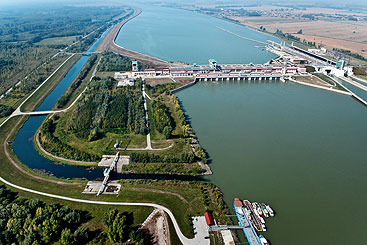Can hydropower and river ecosystems get along?

Can hydropower and river ecosystems get along?
Global energy needs are rising rapidly, as are greenhouse gas emissions from economic developments. Hydropower may seem an obvious choice for the provision of clean electricity, yet the negative environmental impacts of hydropower make it necessary to find solutions that will balance energy needs with those of the river.

The Gabčíkovo Dam in Slovakia is the second largest dam on the Danube (after the Iron Gates dam), and is situated downstream of Bratislava.
For most Danube countries, hydropower is important. Countries are turning to clean energy sources to meet renewable energy targets, all the while trying to achieve ‘good quality’ status for water bodies in the Danube River Basin. How can Danube countries bring these seemingly conflicting goals together?
All Danube countries – even non-EU states – have committed themselves to implementing the EU Renewable Energy Directive, which is part of a package of energy and climate change legislation that provides targets for greenhouse gas emission savings. The directive encourages energy efficiency and the use of renewable energy sources. Growing energy demands, increased electricity prices as well as international climate protection targets are a major driver towards the expansion of hydropower generation and the construction of new facilities in some Danube countries.
Negative effects for the environment. However,
hydropower – and the hydromorphological alterations
through the construction of required facilities – can
have negative impacts on the environment. The Danube
River Basin District Management Plan endorsed by
the Danube countries in 2009 identified hydromorphological
alterations as one of the four most significant
water management issues in the Danube River Basin.
Hydromorphological alterations can cause river and habitat interruptions, disconnect wetlands and floodplains, interrupt sediment transport, provoke changes in the natural structure of rivers such as river depth, width and flow regimes as well as interrupt natural fish migration routes.
In addition, these effects work against efforts to meet the requirements of the EU Water Framework Directive and its river protection goals to ensure that all waters achieve the ‘good status’ by 2015, a goal all Danube countries have committed to. The big question for countries is how to balance the seemingly conflicting needs of both the EU Water Framework Directive as well as the EU Renewable Energy Directive.
“The main – and extremely demanding – challenge is to find the right balance between increasing energy demand as well as energy savings and the protection of waters and ecology,” says Karl Schwaiger, Head of the Austrian Delegation to the ICPDR.
Working toward guidelines. The Danube Declaration, signed by Danube countries in 2010, asked the ICPDR to work in close cooperation with the hydropower sector and all relevant stakeholders to integrate the needs of energy and the environment. Specifically, the Declaration called for “a broad discussion process with the aim of developing guiding principles on integrating environmental aspects in the use of existing hydropower plants, including a possible increase of their efficiency, as well as in the planning and construction of new hydropower plants”.
Three lead countries – Austria, Romania and Slovenia – were nominated to steer the process of developing these guiding principles on hydropower in the frame of the ICPDR. These countries are supported by a Team of Experts, which includes representatives from the energy and environmental administrations of different Danube countries, as well as NGOs and other stakeholder groups. The team supports integration of the different objectives, and provides knowledge and input on the process.
For the ICPDR hydropower activity to succeed, the full participation of key players from both the environmental and energy sectors is vital. “It is necessary that this process is an inclusive one, so that all stakeholders have the possibility to contribute in this shared process to develop sustainable and viable solutions,” says Schwaiger. “Thus the involvement of all stakeholders is really crucial to achieve viable and environmentally acceptable solutions.”
Gathering data. The first step in the process is to develop an Assessment Report on Hydropower Generation in the Danube Basin, an advanced version of which was presented and discussed in February 2012. The report is based on answers to questionnaires sent to all Danube countries in August 2011, as well as on data from reports, documents and other databases (such as those of the ICPDR and the European Union).
The Assessment Report summarises key information on hydropower generation in the context of water management, flood protection, biodiversity and nature protection. In parallel, the collection of case studies and good practice examples on hydropower is ongoing. This input provides the basis for discussions and facilitates the development of the Guiding Principles on Hydropower.

All Danube countries – even non-EU states – have committed themselves to implementing the EU Renewable Energy Directive, which encourages energy efficiency and the use of renewable energy sources. Depicted here is Kraftwerk Vohburg in Bavaria, Germany.
Getting all stakeholders together. A first ICPDR Workshop on Hydropower and Water Management, organised by Romania, was held from 21 to 22 February 2012 in Timisoara, Romania. Representatives from water management and the energy sector, including representatives from the International Hydropower Association, European Small Hydropower Association and Energy Community, discussed the draft findings of the Assessment Report as well as ways to develop a common framework to implement the requirements of renewable energy and hydropower with those of water and environment protection. Participants shared practical experience in balancing these two goals, and discussed the elaboration of the Guiding Principles.
“The workshop has given the team of members more suggestions than expected to work toward the Guiding Principles,” says Aleš Bizjak of the Institute for Water of the Republic of Slovenia and representing Slovenia as one of the lead countries steering the activity. “The core group countires together with the ICPDR Secretariat are looking forward to work on issues and to finish the process next year in the best possible way.”
A second workshop will be organised to present the results and outcomes of the work achieved to that point, and to pave the way for broad acceptance and practical implementation of the main outcomes and findings.
Looking to models of cooperation. The Assessment Report and the work towards the Guiding Principles build on experiences in other processes throughout the region. In particular, it builds on the work under the Common Implementation Strategy (CIS) ad hoc activity ‘Hydromorphology’. The CIS is an EU process supporting the implementation of the Water Framework Directive, and various activities under this process, including two EU workshops on hydropower and the Water Framework Directive.
Furthermore, the ICPDR activity on hydropower builds on the Danube River Basin District Management Plan, as well as the outcome of the activities of the Alpine Convention regarding Hydropower Generation in the Alpine Region focusing on Small Hydropower. In addition, the collaborative work on the ‘Joint Statement on Guiding Principles on the Development of Inland Navigation and Environmental Protection in the Danube River Basin’, published in 2008, has been a model for cooperation between sectors.
Shared solutions. Progress toward the Guiding Principles will link to the ongoing activities under the European Strategy for the Danube Region, which aims to improve coordination and cooperation between countries to address challenges in the Danube region. It focuses on eleven priority areas, which are also related to hydropower and environmental protection. Specific actions under Priority Area 2, ‘Encourage More Sustainable Energy’, requires comprehensive action plans for the sustainable development of the hydropower generation potential, to allocate suitable areas for new hydropower plants as well as to develop and set up a pre-planning mechanism for the allocation of suitable areas for new hydropower projects. The ICPDR process, therefore, also contributes toward the implementation of the EU Strategy for the Danube Region.
Close contact with coordinators for Priority Area 2, as well as for Priority Areas 4 and 5 (‘Restore and Maintain Quality of Waters’ and ‘Manage Environmental Risks’) will be crucial to ensure that there is no duplication or overlapping of work regarding hydropower generation in the Danube River Basin.
Meeting the challenge of satisfying global energy needs while reducing greenhouse gas emissions and protecting freshwater ecosystems requires new approaches. Decisions about hydropower plants can no longer be made in isolation as they are part of a suite of solutions for meeting energy needs. Through the collaboration of all stakeholders, Danube countries are working to find a balance between these needs.






